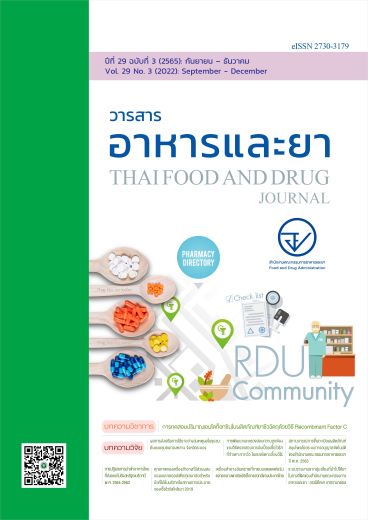การปฏิเสธการนำเข้าอาหารไทยที่ส่งออกไปยังสหรัฐอเมริกาปี พ.ศ. 2554-2563
Main Article Content
บทคัดย่อ
ความสำคัญ: สหรัฐอเมริกาเป็นตลาดส่งออกสินค้าอุตสาหกรรมเกษตรหลักของไทย โดยมีมูลค่าการส่งออกไม่ต่ำกว่า 7 หมื่นล้านบาทในแต่ละปี อย่างไรก็ตาม สินค้าบางส่วนถูกปฏิเสธการนำเข้าโดยองค์การอาหารและยาแห่งสหรัฐอเมริกาเนื่องจากการละเมิดกฎหมายด้านความปลอดภัยทางอาหาร
วัตถุประสงค์: เพื่อวิเคราะห์สถานการณ์และสาเหตุการปฏิเสธการนำเข้าอาหารไทยโดยองค์การอาหารและยาแห่งสหรัฐอเมริกา
วิธีการวิจัย: เป็นการศึกษาย้อนหลัง 10 ปี โดยใช้ข้อมูลการปฏิเสธสินค้าอาหารนำเข้าจากประเทศไทยที่ส่งออกไปยังสหรัฐอเมริกาในช่วง พ.ศ. 2554–2563 จากฐานข้อมูล Import Refusal Report ขององค์การอาหารและยาแห่งสหรัฐอเมริกา (U.S. FDA) มาวิเคราะห์แนวโน้มและสาเหตุการปฏิเสธการนำเข้าสินค้าอาหารกลุ่มต่าง ๆ
ผลการศึกษา: ในช่วง พ.ศ. 2554–2563 U.S. FDA ปฏิเสธการนำเข้าสินค้าอาหารจากประเทศไทยเฉลี่ยร้อยละ 0.143 ต่อปี โดยการปฏิเสธสินค้ามีแนวโน้มลดลง สาเหตุหลักมาจากอาหารปลอมปน ร้อยละ 70.2 ซึ่งเป็นตัวบ่งชี้สุขอนามัยในการผลิตอาหาร สำหรับสินค้าที่มีการปฏิเสธการนำเข้ามากที่สุดคือผลิตภัณฑ์อาหารทะเล ร้อยละ 35.78 โดยมีสาเหตุหลักมาจากสิ่งแปลกปลอมทางชีวภาพ ฮิสทามีน การขาดระบบ HACCP และ Salmonella รองลงมาคือผลิตภัณฑ์ผลไม้ ร้อยละ 23.88 ซึ่งมีสาเหตุหลักมาจากสิ่งแปลกปลอมทางชีวภาพ การขาดระบบ HACCP และสารกำจัดศัตรูพืช กลุ่มเครื่องเทศ เครื่องปรุงรส และน้ำพริก ร้อยละ 11.90 มีสาเหตุหลักมาจากสารกำจัดศัตรูพืช Salmonella และสิ่งแปลกปลอมทางชีวภาพ ผลิตภัณฑ์ผัก ร้อยละ 8.00 มีสาเหตุหลักมาจากการไม่ขึ้นทะเบียนสถานที่ผลิตอาหารกระป๋องและสภาวะการแปรรูป และฉลากอาหารไม่ถูกต้อง
สรุป: จำนวนการปฏิเสธการนำเข้าของ U.S. FDA มีแนวโน้มลดลง อย่างไรก็ตาม การพบสิ่งแปลกปลอมทางชีวภาพและฉลากอาหารที่ไม่ถูกต้องเป็นสาเหตุสำคัญที่พบอย่างต่อเนื่องทุกปี ดังนั้น สำนักงานคณะกรรมการอาหารและยาควรพิจารณาตรวจประเมินสถานที่ผลิตอาหารที่ตรวจพบสิ่งแปลกปลอมทางชีวภาพเพื่อเสนอแนะแนวทางการปรับปรุงสถานที่ผลิตอาหาร นอกจากนี้หน่วยงานที่เกี่ยวข้องควรบูรณาการเพื่อให้คำแนะนำเกี่ยวกับกฎหมายอาหารของประเทศผู้นำเข้า โดยเฉพาะฉลากอาหาร เพื่อลดอัตราการปฏิเสธสินค้าจากประเทศปลายทาง
Article Details

อนุญาตภายใต้เงื่อนไข Creative Commons Attribution 4.0 International License.
เอกสารอ้างอิง
กระทรวงพาณิชย์. การค้าไทย [อินเทอร์เน็ต]. 2564 [เข้าถึงเมื่อ 19 พ.ย. 2564]. เข้าถึงจาก: https://tradereport.moc.go.th/TradeThai.aspx
Kushner GJ, Hermida MG, Eyink BD. United States of America. In: Kirchsteiger-Meier E, Baumgartner T, editors. Global Food Legislation: An Overview. Weinheim: Wiley-VCH; 2014. p. 279–306.
FDA. Import Refusal Report [Internet]. 2015 [cited 2021 Jun 10]. Available from: https://www.accessdata.fda.gov/scripts/ImportRefusals/index.cfm
Fortin ND. Food Regulation: Law, Science, Policy, and Practice. 2nd ed. Hoboken: John Wiley & Sons; 2017.
FSIS. Eligible Foreign Establishments [Internet]. 2022 [cited 2022 Jul 4]. Available from: https://www.fsis.usda.gov/inspection/import-export/import-export-library/eligible-foreign-establishments
FDA. Imports Entry [Internet]. 2022 [cited 2021 Jan 20]. Available from: https://datadashboard.fda.gov/ora/cd/impentry.htm
FDA. Food Defect Levels Handbook [Internet]. 2005 [cited 2021 Jul 15]. Available from: https://www.fda.gov/food/ingredients-additives-gras-packaging-guidance-documents-regulatory-information/food-defect-levels-handbook
ขันทอง เพ็ชรนอก, กนกวรรณ ตุ้นสกุล. สิ่งแปลกปลอมชนิดเบาในผลไม้แห้ง. วารสารอาหารและยา 2564;28(2):51–8.
Bovay J. FDA Refusals of Imported Food Products by Country and Category, 2005-2013. Economic Information Bulletin No. 151 [Internet]. United States Department of Agriculture. 2016 [cited 2022 Jun 27]. Available from: https://ers.usda.gov/publications/pub-details/?pubid=44069
Wen X, Yang Z, Dong H, Fan X, Wang Y. Barriers to sustainable food trade: China’s exports food rejected by the U.S. Food and Drug Administration 2011–2017. Sustain. 2018;10(6):1712.
ตระกูล พรหมจักร, สุวลี ฟองอินทร์. การแจ้งเตือนด้านความปลอดภัยของอาหารไทยที่ส่งออกไปยังสหภาพยุโรป ปี 2553 – 2562. วารสารอาหารและยา 2564;28(3):45–57.
กรมวิชาการเกษตร. การออกใบรับรองคุณภาพสินค้าเกษตรแปรรูปด้านพืชประกอบการส่งออก [อินเทอร์เน็ต]. 2561 [เข้าถึงเมื่อ 19 ม.ค. 2565]. เข้าถึงจาก: https://www.doa.go.th/psco/wp-content/uploads/2020/11/8_เอกสารเผยแพร่-เรื่อง-การออกใบรับรองคุณภาพสินค้าเกษตร.pdf
กรมประมง. เงื่อนไขการตรวจรับรองและการออกใบรับรองสุขอนามัยตามประเทศที่มีข้อกำหนด [อินเทอร์เน็ต]. 2559 [เข้าถึงเมื่อ 19 ม.ค. 2565]. เข้าถึงจาก: https://www.fisheries.go.th/quality/เงื่อนไขการตรวจรับรองและการออกใบรับรองสุขอนามัยตามประเทศที่มีข้อกำหนด.pdf
FDA. Fish and Fishery Products Hazards and Controls Guidance [Internet]. 2021 [cited 2021 Jul 16]. Available from: https://www.fda.gov/food/seafood-guidance-documents-regulatory-information/fish-and-fishery-products-hazards-and-controls
Loi G, Gamarro EG. Border rejection trends of fishery and aquaculture products in European Union, United States of America and Japan. FAO Aquac Newsl. 2018;(58):44–6.
Olgunoğlu İA. Salmonella in Fish and Fishery Products. In: Mahmoud BSM, editor. Salmonella - A Dangerous Foodborne Pathogen. London: IntechOpen; 2012. p. 91-108.
FDA. Summary of Color Additives for Use in the United States in Foods, Drugs, Cosmetics, and Medical Devices [Internet]. 2021 [cited 2021 Nov 18]. Available from: https://www.fda.gov/industry/color-additive-inventories/summary-color-additives-use-united-states-foods-drugs-cosmetics-and-medical-devices#table1B
Harp BP, Barrows JN. US regulation of color additives in foods. In: Scotter MJ, editor. Colour Additives for Foods and Beverages. Oxford: Woodhead Publishing; 2015. p. 75–88.
FDA. Changes to the Nutrition Facts Label [Internet]. 2019 [cited 2019 Aug 10]. Available from: https://www.fda.gov/food/food-labeling-nutrition/changes-nutrition-facts-label
Gale F, Buzby JC. Imports from China and food safety issues. Economic Information Bulletin Number 52 [Internet]. United States Department of Agriculture. 2009 [cited 2022 Jun 27]. Available from: https://ers.usda.gov/publications/pub-details/?pubid=44392
Zhou J, Wang Y, Mao R. Dynamic and spillover effects of USA import refusals on China’s agricultural trade: Evidence from monthly data. Agric Econ. 2019;65(9):425–34.
FDA. Food Allergies [Internet]. 2021 [cited 2021 Nov 8]. Available from: https://www.fda.gov/food/food-labeling-nutrition/food-allergies
Timbo B, Koehler KM, Wolyniak C, Klontz KC. Sulfites-A Food and Drug Administration Review of Recalls and Reported Adverse Events. J Food Prot [Internet]. 2004;67(8):1806–11.
Khan M, Lively JA. Determination of sulfite and antimicrobial residue in imported shrimp to the USA. Aquac Reports. 2020;18:100529.
FDA. Establishment Registration & Process Filing for Acidified and Low-Acid Canned Foods (LACF) [Internet]. 2020 [cited 2021 Nov 17]. Available from: https://www.fda.gov/food/registration-food-facilities-and-other-submissions/establishment-registration-process-filing-acidified-and-low-acid-canned-foods-lacf
Buzby JC, Unnevehr LJ, Roberts D. Food Safety and Imports: An Analysis of FDA Food-Related Import Refusal Reports. Economic Information Bulletin Number 39 [Internet]. United States Department of Agriculture. 2008 [cited 2022 Jun 27]. Available from: https://ers.usda.gov/publications/pub-details/?pubid=44259


